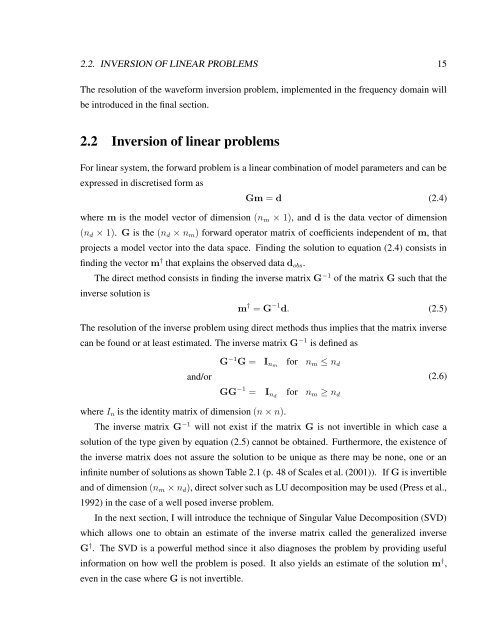Sirgue, Laurent, 2003. Inversion de la forme d'onde dans le ...
Sirgue, Laurent, 2003. Inversion de la forme d'onde dans le ...
Sirgue, Laurent, 2003. Inversion de la forme d'onde dans le ...
You also want an ePaper? Increase the reach of your titles
YUMPU automatically turns print PDFs into web optimized ePapers that Google loves.
2.2. INVERSION OF LINEAR PROBLEMS 15<br />
The resolution of the waveform inversion prob<strong>le</strong>m, imp<strong>le</strong>mented in the frequency domain will<br />
be introduced in the final section.<br />
2.2 <strong>Inversion</strong> of linear prob<strong>le</strong>ms<br />
For linear system, the forward prob<strong>le</strong>m is a linear combination of mo<strong>de</strong>l parameters and can be<br />
expressed in discretised form as<br />
Gm = d (2.4)<br />
where m is the mo<strong>de</strong>l vector of dimension (n m × 1), and d is the data vector of dimension<br />
(n d × 1). G is the (n d × n m ) forward operator matrix of coefficients in<strong>de</strong>pen<strong>de</strong>nt of m, that<br />
projects a mo<strong>de</strong>l vector into the data space. Finding the solution to equation (2.4) consists in<br />
finding the vector m † that exp<strong>la</strong>ins the observed data d obs .<br />
The direct method consists in finding the inverse matrix G −1 of the matrix G such that the<br />
inverse solution is<br />
m † = G −1 d. (2.5)<br />
The resolution of the inverse prob<strong>le</strong>m using direct methods thus implies that the matrix inverse<br />
can be found or at <strong>le</strong>ast estimated. The inverse matrix G −1 is <strong>de</strong>fined as<br />
and/or<br />
G −1 G = I nm for n m ≤ n d<br />
GG −1 = I nd for n m ≥ n d<br />
(2.6)<br />
where I n is the i<strong>de</strong>ntity matrix of dimension (n × n).<br />
The inverse matrix G −1 will not exist if the matrix G is not invertib<strong>le</strong> in which case a<br />
solution of the type given by equation (2.5) cannot be obtained. Furthermore, the existence of<br />
the inverse matrix does not assure the solution to be unique as there may be none, one or an<br />
infinite number of solutions as shown Tab<strong>le</strong> 2.1 (p. 48 of Sca<strong>le</strong>s et al. (2001)). If G is invertib<strong>le</strong><br />
and of dimension (n m × n d ), direct solver such as LU <strong>de</strong>composition may be used (Press et al.,<br />
1992) in the case of a well posed inverse prob<strong>le</strong>m.<br />
In the next section, I will introduce the technique of Singu<strong>la</strong>r Value Decomposition (SVD)<br />
which allows one to obtain an estimate of the inverse matrix cal<strong>le</strong>d the generalized inverse<br />
G † . The SVD is a powerful method since it also diagnoses the prob<strong>le</strong>m by providing useful<br />
information on how well the prob<strong>le</strong>m is posed. It also yields an estimate of the solution m † ,<br />
even in the case where G is not invertib<strong>le</strong>.

















